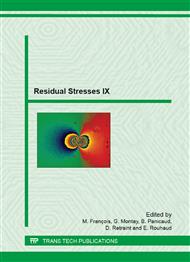[1]
Pilloz, M., Sahour, C. & Vannes, B. (1989). Study of the parameters of laser coatings and residual stress field created by these coating. Proceedings of 2nd Int. Seminar on Surface Engineering with High Energy Beams, Lisbon, (1989), pp.387-413.
DOI: 10.4028/www.scientific.net/kem.46-47.387
Google Scholar
[2]
Freitas, M., Fereira, M.S. & Michaud, H. (1993). Analysis of residual stresses induced by laser processing. Mat. Sci. Eng, Vol. 167, (1993), pp.115-122.
Google Scholar
[3]
J. B. Leblond, G. Mottet, J. Devaux, J. C. Devaux, Mathematical models of anisothermal phase transformations in steels, and predicted plastic behaviour, Mater. Sci. Technol., 1 (1985) 815-822.
DOI: 10.1179/mst.1985.1.10.815
Google Scholar
[4]
R.A. Winholtz, J.B. Cohen, Generalised Least-squares Determination of Triaxial Stress States by X-ray Diffraction and the Associated Errors, Aust. J. Phys. 41 (1988) 189-199.
DOI: 10.1071/ph880189
Google Scholar
[5]
M. G. Moore, W. P. Evans, Mathematical correlation for stress in removed layers in X-ray diffraction residual stress analysis, SAE Trans. 66 (1958) 340.
DOI: 10.4271/580035
Google Scholar
[6]
C.L. Azanza Ricardo, M. D'Incau, P. Scardi, Revision and extension of the standard laboratory technique for X-ray diffraction measurement of residual stress gradients, J. Appl. Cryst. 40 (2007) 675-683.
DOI: 10.1107/s0021889807022935
Google Scholar
[7]
Information on http: /www. vishaypg. com.
Google Scholar
[8]
ASTM E 837 – 08: Determining Residual Stresses by the Hole – Drilling Strain-Gage Method.
Google Scholar
[9]
Benedek, J., Shachrai, A. & Levin, L. (1980). Case hardening of steel by a CO2 laser beam. Optics and Laser Technology, Vol. 12, (1980), pp.247-253.
DOI: 10.1016/0030-3992(80)90051-1
Google Scholar
[10]
Vilar, R., Colaço, R. & Almeida, A. (1995). Laser surface treatment of tool steels. Optical and Quantum Electronics, Vol. 27, (1995), pp.1273-1289.
Google Scholar
[11]
Kostov V., Bibmeier J., Wanner A., Laser Surface Hardening of Steel: Effect of Process Atmosphere on the Microstructure and Residual Stresses, Mat. Sci. Forum 681 (2011) 321-326.
DOI: 10.4028/www.scientific.net/msf.772.149
Google Scholar


